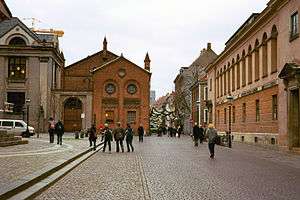Fiolstræde

Fiolstræde is a pedestrianised shopping street in central Copenhagen, Denmark. It passes the square Frue Plads on its way from Nørreport station in the north to Skindergade in the south where Jorcks Passage connects it to the shopping street Strøget. Copenhagen Cathedral is located in the street which also passes the rear side of Copenhagen University Library.[1]
History
.jpg)

The area along the street was until the 17th century dominated by green areas and the more likely refers to the violet flower (Danish: viol) rather than the fiddle (Danish: Fiol).[2] The section from Nørre Voldgade to Krystalgade was originally called Store Fiolstræde (Large Violet Alley) while the section from Krystalgade to Skindergade was called Lille Fiolstræde (Small Violet Alley).[3]
Ludvig Holberg lived the last years of his life (died 1754) in a professorial residence at No. 8. The building was destroyed during the British bombardment of Copenhagen in 1807. A plaque on the wall at No. 8 commemorates the event.[4]
The street was formerly known for its many used bookstores.[3] Fiolstræde was pedestrianised in 1968 following the successful pedestrianisation of Strøget in the early 1960s.[5] The narrow street (8 metres) was considered a natural second phase in the pedestrianisation of the area after the closure of Strøget in 1962.
Notable buildings and residents

The most notable building in the street is the former Copenhagen University Library. It was completed in 1861 to a Historicist design by Johan Daniel Herholdt.
.jpg)
No. 4–6 is the former Metropolitan School from 1811–15. It was designed by Christian Frederik Hansen whowas also responsible for the rebuilding of Church of Our Lady on the other side of the street in the years after the British bombardment.
Hotel Sankt Petri is located in the former Daells Varehus department store. Built in 1935, it was one of the first buildings designed by Vilhelm Lauritzen and one of the earliest Modernist buildings in Copenahgen.
No. 8, Stiftsprovstsboligen, located on the corner of Store Kanikkestræde, was built in 1841 as official residence for the provost (Stiftsprovst) at Church of Our Lady. The house and a section of wall shielding the courtyard from the street was listed in 1939.

.
No. 11 (1828), No. 12–14 (1839), No. 13 (1831), No. 15 (1834), No. 16 (1732), No. 17 (1851), No. 18 (1734), No. 19 (1836), No. 20 (1811), No. 21 (1836), No. 12 (1835), No. 24 (1857), No. 25–27 (13–15), No. 26 (1809), No. 28 (1814–51), No. 29 (1810), No. 30—32 (1809/1823), No. 34–36 (1812), No. 38 (1827) and No. 40–42 (1828) are also listed.
The Neo-Baroque building with a rounded corner on Nørre Voldgade was built for the School of Merchantry (Købmandsskolen) in 1902 to design by Valdemar and Bernhard Ingemann. It still houses one of the campuses of Niels Brock Copenhagen Business College.
Today
Today pedestrian traffic is consistent throughout the year due to the presence of students during winter (about 11-12,000 people daily). However, it is a quiet street on weekends and evenings.[5]
References
- ↑ "Universitetsbiblioteket, Fiolstræde 1". Selskabet for Københavns Historie. Retrieved 2010-02-16.
- ↑ "Fiolstræde". indenforvoldene.dk (in Danish). Retrieved 7 October 2015.
- 1 2 "Nedlagte gader og stræder". indenforvoldene.dk (in Danish). Retrieved 7 October 2015.
- ↑ "Fiolstræde 8". indenforvoldene.dk (in Danish). Retrieved 7 October 2015.
- 1 2 Gehl, Jan; Gemzøe, Lars (1996). Public Spaces, Public Life, Copenhagen. The Danish Architectural Press and the Royal Danish Academy of Fine Arts. p. 13. ISBN 877 407 305 2.
External links
| Wikimedia Commons has media related to Fiolstræde. |
- Fiolstræde on indenforvoldene.dk
Coordinates: 55°40′53″N 12°34′21″E / 55.68139°N 12.57250°E